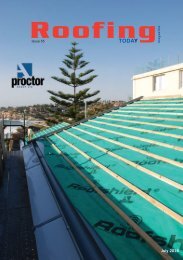Roofing
2kZ2j9o
2kZ2j9o
Create successful ePaper yourself
Turn your PDF publications into a flip-book with our unique Google optimized e-Paper software.
Working at Height<br />
We Need to Talk About Fragile Roof Access<br />
A staggering number of falls from height continue to be linked with fragile roofs. Employers<br />
risk substantial fines and court appearances due to unsafe working conditions and not<br />
following the correct procedures for employees to remain safe.<br />
Soni Sheimer, General Manager at Easi-Dec,<br />
takes a look at the range of options and solutions<br />
that are available when working at height.<br />
Selecting the right equipment is key to<br />
reducing the risk of accidents and falls from<br />
height. It needs to be secure, easy to<br />
access and meet required regulations.<br />
From the contractor’s point of view, it’s<br />
also helpful if the system selected is easy<br />
to install, available at short notice and<br />
offers good value for money.<br />
Access to industrial rooftops requires<br />
solutions that are designed to overcome the<br />
challenges of working on fragile roofs and<br />
provide the user with a safe working<br />
position for skin maintenance, inspection,<br />
cleaning and re-sealing work. A range of<br />
products are available to provide safety<br />
systems that are suitable for all<br />
requirements and simplify short duration<br />
roof work.<br />
There are three main types of access<br />
systems that can be considered for<br />
accessing industrial roof tops – mesh<br />
walkways, rolling platforms and mobile<br />
walking frames.<br />
Mesh walkways are a great option when<br />
access is needed to run from the eaves to<br />
ridge. It provides the benefit of spreading the weight across the support<br />
battens, allowing workers to confidently move along the full length of<br />
the system. Opting for a solution that is made from high grade<br />
aluminium ensures the structure is robust, lightweight, and easily<br />
transportable.<br />
A fully guarded rolling platform, which is mounted on twin racks, allows<br />
workers to move up and down the roof on a secure and level surface.<br />
Requiring no penetration, the structure is easy to assemble and take<br />
down, and is possible to transport quickly to other parts of the roof. The<br />
platform moves along a linking track which is fitted with safety mesh<br />
and battens to provide further support.<br />
Lightweight mobile walking frames are designed to provide safe access<br />
for one or two people when working along valley gutters. The outriggers<br />
are filled with safety mesh and cushioned for comfort. This system can<br />
also be used to transport light payloads. Suitable for typical symmetrical<br />
valleys, the system could also be fully adjustable to suit uneven designs.<br />
Specifying these types of systems presents contractors with a quicker,<br />
more cost-effective and more practical approach to rooftop access, and<br />
will ensure that they and their employers comply fully with the<br />
requirements of the Work at Height Regulations. It’s a win-win for both<br />
parties.<br />
For full details on Easi-Dec’s industrial roof access solutions, visit<br />
www.easi-dec.co.uk . Full technical support and advice is available direct<br />
from the company Tel: 01767 691812.<br />
Industrial roofing is prone to being fragile, with various weak spots and uneven surfaces often making it<br />
an unsafe environment for workers undertaking rooftop tasks. According to the Health and Safety<br />
Executive (HSE), falls from height remain one of the most common causes of fatality and major injury in<br />
the UK. The 2015/2016 national figures report that there were 37 fatalities as a result of falls from height,<br />
while on average 7 people are killed each year after falling through a fragile roof or roof light.<br />
The key piece of legislation is the Work at Height Regulations 2005, as amended by the Work at Height<br />
(Amendment) Regulations 2007, which places a legal requirement for anyone who contracts others to<br />
access and maintain rooftop equipment on public buildings and housing developments to ensure proper<br />
safety precautions are in place. Breaching these regulations can result in a legal prosecution and both<br />
substantial fines or possible imprisonment.<br />
The recent case of an engineering construction company fined £267,000 with costs, after a worker suffered<br />
severe injuries from falling through a fibreboard barn roof, is a timely example. The HSE’s investigation<br />
found that there were insufficient platforms or coverings for the roof to protect workers from falling<br />
through the roof and that the risk assessment and method statement which should have told the workers<br />
how to carry out the work safely was left in the office. The company pleaded guilty to a breaching<br />
Sections 4 and 9 of the Working at Height Regulations.<br />
The case highlighted that it is essential that all work at height is properly planned and carried out by<br />
competent members of staff to ensure that minimal accidents occur. It is also the contractor’s own<br />
responsibility to train to safely work at height, ensuring that they understand and work within the<br />
regulations.<br />
Enquiry 48<br />
Page 26 <strong>Roofing</strong> Today<br />
<strong>Roofing</strong> Today Page 27




